Waste Water Treatment Plant Operations and Nutrient Removal Analysis
VerifiedAdded on 2023/01/06
|8
|2064
|49
Report
AI Summary
This report provides a detailed overview of wastewater treatment plant (WWTP) operations, using the Loganholme WWTP as a case study. It begins with an introduction to various WWTP processes, including primary sedimentation, grit removal, screening, and disinfection. The report then presents a process flow diagram illustrating the sequence of operations at the Loganholme plant, followed by an in-depth discussion on the significance of nutrient removal, explaining the methods and importance of removing nutrients like nitrogen and phosphorus. Furthermore, the report highlights the importance of disinfecting final effluents. The report also includes a literature review on relevant topics such as foam generation and control in WWTPs and provides recommendations for addressing operational challenges. The Loganholme WWTP is described, with a focus on its design capacity and the biological and physical procedures used, including the use of oxidation ditches and biological nutrient removal systems. Finally, the report emphasizes the importance of each stage in the wastewater treatment process, from screening to sludge disposal.
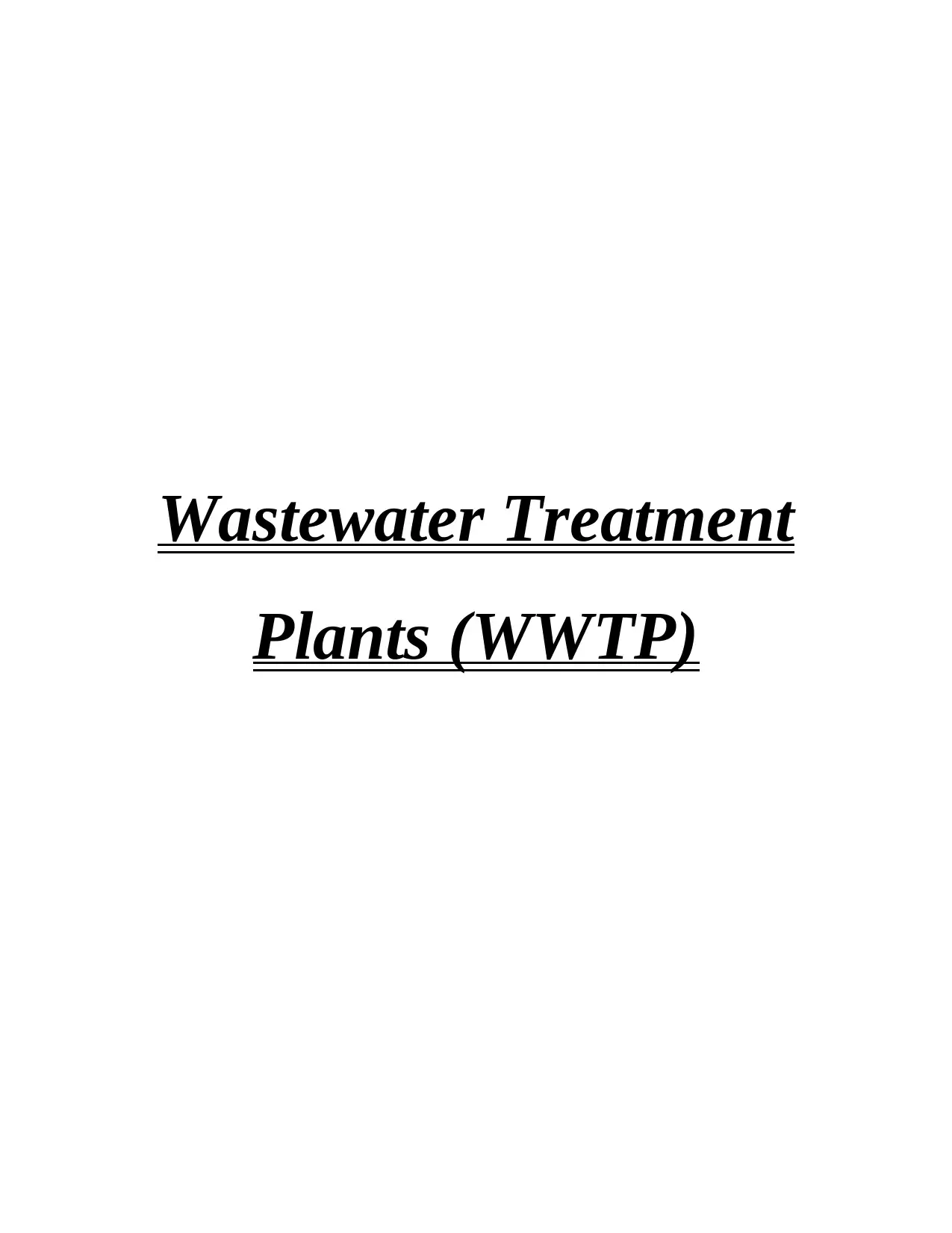
Wastewater Treatment
Plants (WWTP)
Plants (WWTP)
Paraphrase This Document
Need a fresh take? Get an instant paraphrase of this document with our AI Paraphraser
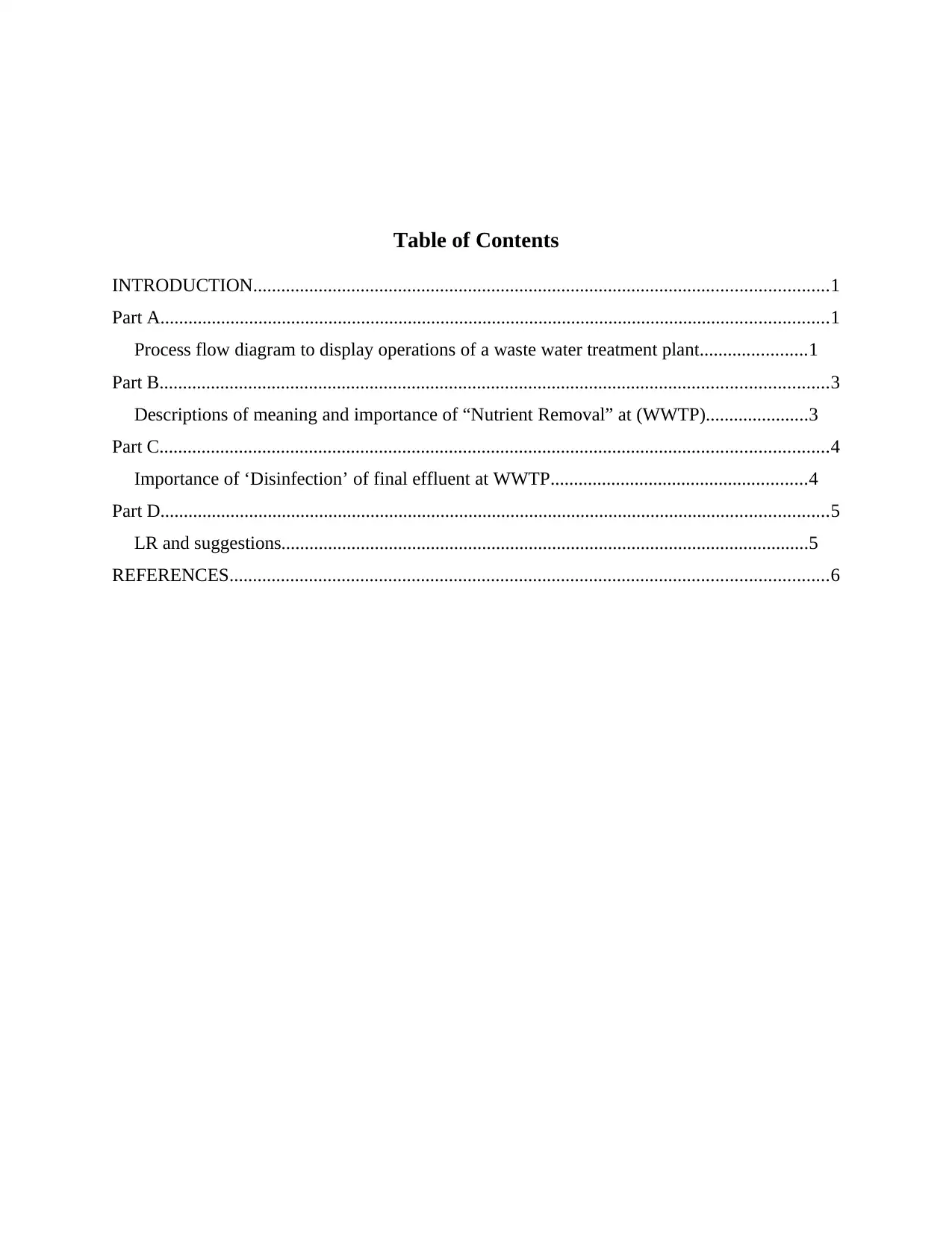
Table of Contents
INTRODUCTION...........................................................................................................................1
Part A...............................................................................................................................................1
Process flow diagram to display operations of a waste water treatment plant.......................1
Part B...............................................................................................................................................3
Descriptions of meaning and importance of “Nutrient Removal” at (WWTP)......................3
Part C...............................................................................................................................................4
Importance of ‘Disinfection’ of final effluent at WWTP.......................................................4
Part D...............................................................................................................................................5
LR and suggestions.................................................................................................................5
REFERENCES................................................................................................................................6
INTRODUCTION...........................................................................................................................1
Part A...............................................................................................................................................1
Process flow diagram to display operations of a waste water treatment plant.......................1
Part B...............................................................................................................................................3
Descriptions of meaning and importance of “Nutrient Removal” at (WWTP)......................3
Part C...............................................................................................................................................4
Importance of ‘Disinfection’ of final effluent at WWTP.......................................................4
Part D...............................................................................................................................................5
LR and suggestions.................................................................................................................5
REFERENCES................................................................................................................................6
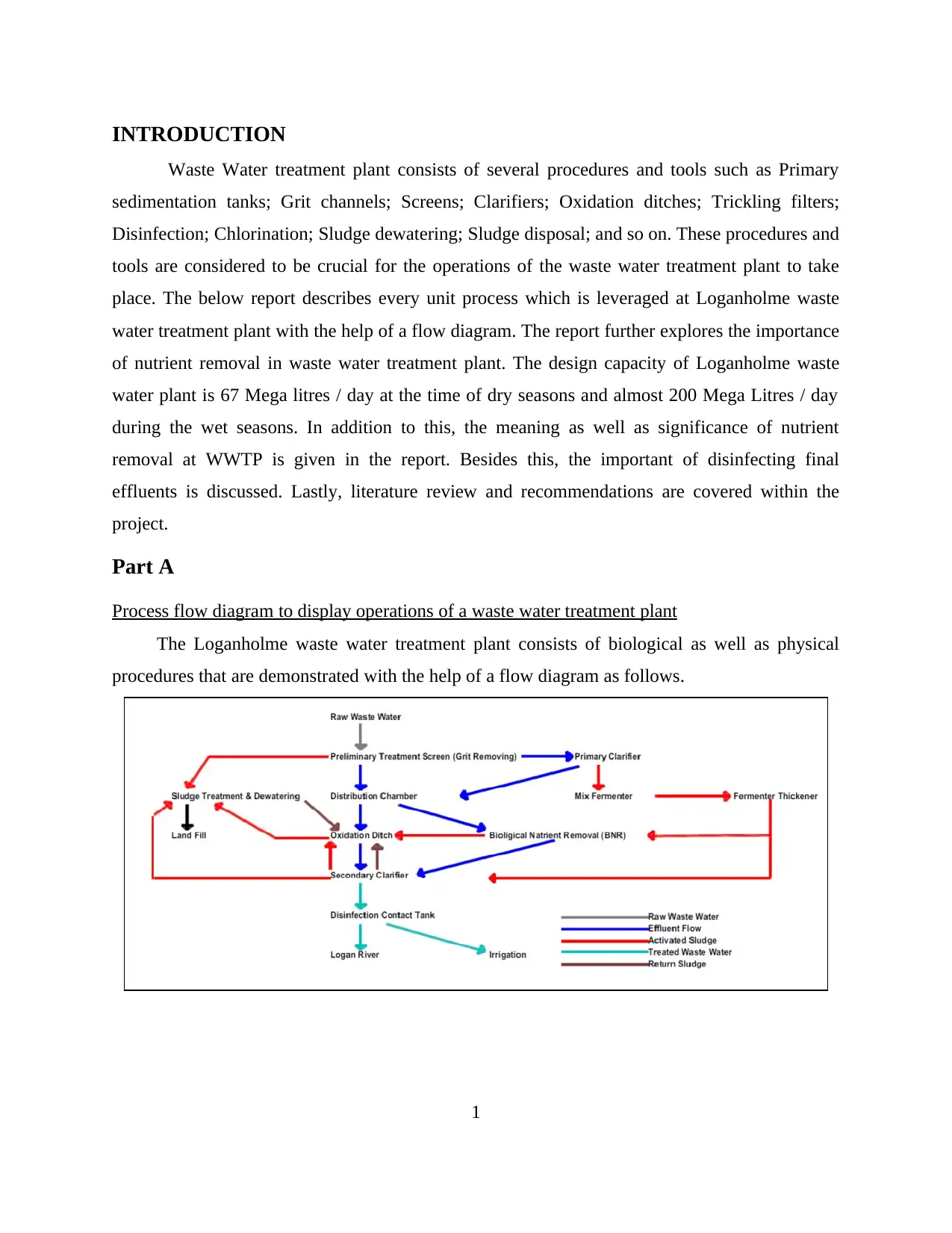
INTRODUCTION
Waste Water treatment plant consists of several procedures and tools such as Primary
sedimentation tanks; Grit channels; Screens; Clarifiers; Oxidation ditches; Trickling filters;
Disinfection; Chlorination; Sludge dewatering; Sludge disposal; and so on. These procedures and
tools are considered to be crucial for the operations of the waste water treatment plant to take
place. The below report describes every unit process which is leveraged at Loganholme waste
water treatment plant with the help of a flow diagram. The report further explores the importance
of nutrient removal in waste water treatment plant. The design capacity of Loganholme waste
water plant is 67 Mega litres / day at the time of dry seasons and almost 200 Mega Litres / day
during the wet seasons. In addition to this, the meaning as well as significance of nutrient
removal at WWTP is given in the report. Besides this, the important of disinfecting final
effluents is discussed. Lastly, literature review and recommendations are covered within the
project.
Part A
Process flow diagram to display operations of a waste water treatment plant
The Loganholme waste water treatment plant consists of biological as well as physical
procedures that are demonstrated with the help of a flow diagram as follows.
1
Waste Water treatment plant consists of several procedures and tools such as Primary
sedimentation tanks; Grit channels; Screens; Clarifiers; Oxidation ditches; Trickling filters;
Disinfection; Chlorination; Sludge dewatering; Sludge disposal; and so on. These procedures and
tools are considered to be crucial for the operations of the waste water treatment plant to take
place. The below report describes every unit process which is leveraged at Loganholme waste
water treatment plant with the help of a flow diagram. The report further explores the importance
of nutrient removal in waste water treatment plant. The design capacity of Loganholme waste
water plant is 67 Mega litres / day at the time of dry seasons and almost 200 Mega Litres / day
during the wet seasons. In addition to this, the meaning as well as significance of nutrient
removal at WWTP is given in the report. Besides this, the important of disinfecting final
effluents is discussed. Lastly, literature review and recommendations are covered within the
project.
Part A
Process flow diagram to display operations of a waste water treatment plant
The Loganholme waste water treatment plant consists of biological as well as physical
procedures that are demonstrated with the help of a flow diagram as follows.
1
⊘ This is a preview!⊘
Do you want full access?
Subscribe today to unlock all pages.

Trusted by 1+ million students worldwide
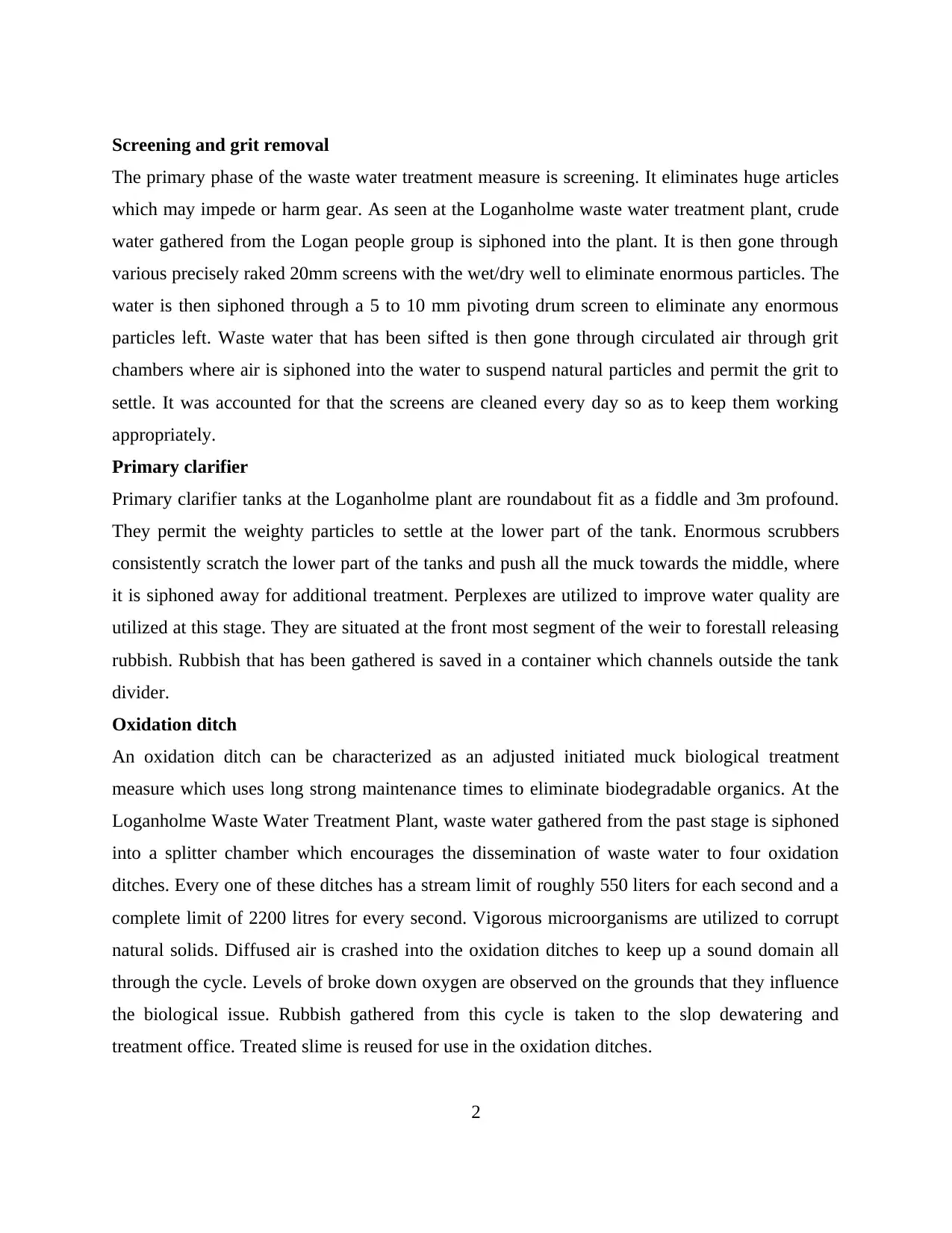
Screening and grit removal
The primary phase of the waste water treatment measure is screening. It eliminates huge articles
which may impede or harm gear. As seen at the Loganholme waste water treatment plant, crude
water gathered from the Logan people group is siphoned into the plant. It is then gone through
various precisely raked 20mm screens with the wet/dry well to eliminate enormous particles. The
water is then siphoned through a 5 to 10 mm pivoting drum screen to eliminate any enormous
particles left. Waste water that has been sifted is then gone through circulated air through grit
chambers where air is siphoned into the water to suspend natural particles and permit the grit to
settle. It was accounted for that the screens are cleaned every day so as to keep them working
appropriately.
Primary clarifier
Primary clarifier tanks at the Loganholme plant are roundabout fit as a fiddle and 3m profound.
They permit the weighty particles to settle at the lower part of the tank. Enormous scrubbers
consistently scratch the lower part of the tanks and push all the muck towards the middle, where
it is siphoned away for additional treatment. Perplexes are utilized to improve water quality are
utilized at this stage. They are situated at the front most segment of the weir to forestall releasing
rubbish. Rubbish that has been gathered is saved in a container which channels outside the tank
divider.
Oxidation ditch
An oxidation ditch can be characterized as an adjusted initiated muck biological treatment
measure which uses long strong maintenance times to eliminate biodegradable organics. At the
Loganholme Waste Water Treatment Plant, waste water gathered from the past stage is siphoned
into a splitter chamber which encourages the dissemination of waste water to four oxidation
ditches. Every one of these ditches has a stream limit of roughly 550 liters for each second and a
complete limit of 2200 litres for every second. Vigorous microorganisms are utilized to corrupt
natural solids. Diffused air is crashed into the oxidation ditches to keep up a sound domain all
through the cycle. Levels of broke down oxygen are observed on the grounds that they influence
the biological issue. Rubbish gathered from this cycle is taken to the slop dewatering and
treatment office. Treated slime is reused for use in the oxidation ditches.
2
The primary phase of the waste water treatment measure is screening. It eliminates huge articles
which may impede or harm gear. As seen at the Loganholme waste water treatment plant, crude
water gathered from the Logan people group is siphoned into the plant. It is then gone through
various precisely raked 20mm screens with the wet/dry well to eliminate enormous particles. The
water is then siphoned through a 5 to 10 mm pivoting drum screen to eliminate any enormous
particles left. Waste water that has been sifted is then gone through circulated air through grit
chambers where air is siphoned into the water to suspend natural particles and permit the grit to
settle. It was accounted for that the screens are cleaned every day so as to keep them working
appropriately.
Primary clarifier
Primary clarifier tanks at the Loganholme plant are roundabout fit as a fiddle and 3m profound.
They permit the weighty particles to settle at the lower part of the tank. Enormous scrubbers
consistently scratch the lower part of the tanks and push all the muck towards the middle, where
it is siphoned away for additional treatment. Perplexes are utilized to improve water quality are
utilized at this stage. They are situated at the front most segment of the weir to forestall releasing
rubbish. Rubbish that has been gathered is saved in a container which channels outside the tank
divider.
Oxidation ditch
An oxidation ditch can be characterized as an adjusted initiated muck biological treatment
measure which uses long strong maintenance times to eliminate biodegradable organics. At the
Loganholme Waste Water Treatment Plant, waste water gathered from the past stage is siphoned
into a splitter chamber which encourages the dissemination of waste water to four oxidation
ditches. Every one of these ditches has a stream limit of roughly 550 liters for each second and a
complete limit of 2200 litres for every second. Vigorous microorganisms are utilized to corrupt
natural solids. Diffused air is crashed into the oxidation ditches to keep up a sound domain all
through the cycle. Levels of broke down oxygen are observed on the grounds that they influence
the biological issue. Rubbish gathered from this cycle is taken to the slop dewatering and
treatment office. Treated slime is reused for use in the oxidation ditches.
2
Paraphrase This Document
Need a fresh take? Get an instant paraphrase of this document with our AI Paraphraser
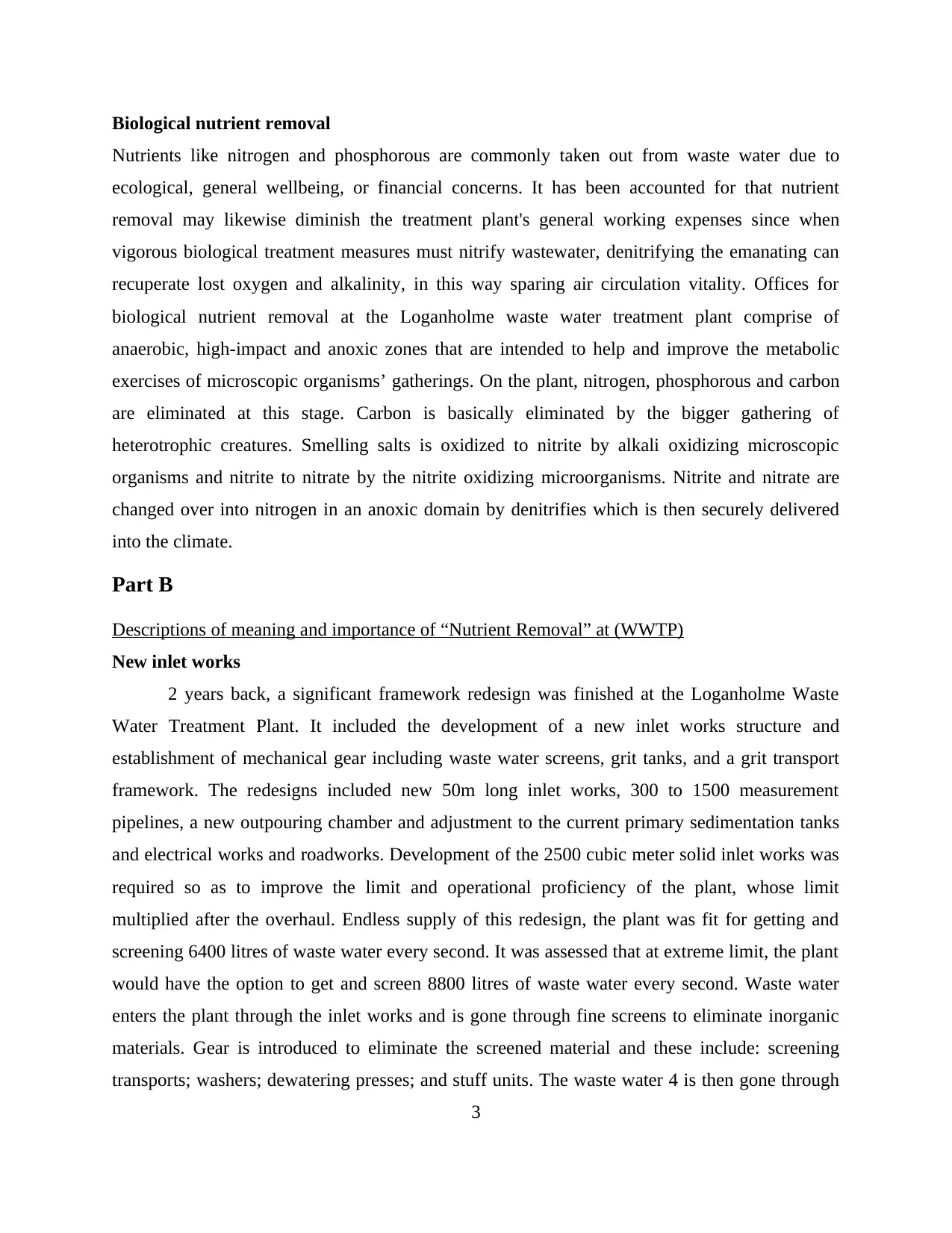
Biological nutrient removal
Nutrients like nitrogen and phosphorous are commonly taken out from waste water due to
ecological, general wellbeing, or financial concerns. It has been accounted for that nutrient
removal may likewise diminish the treatment plant's general working expenses since when
vigorous biological treatment measures must nitrify wastewater, denitrifying the emanating can
recuperate lost oxygen and alkalinity, in this way sparing air circulation vitality. Offices for
biological nutrient removal at the Loganholme waste water treatment plant comprise of
anaerobic, high-impact and anoxic zones that are intended to help and improve the metabolic
exercises of microscopic organisms’ gatherings. On the plant, nitrogen, phosphorous and carbon
are eliminated at this stage. Carbon is basically eliminated by the bigger gathering of
heterotrophic creatures. Smelling salts is oxidized to nitrite by alkali oxidizing microscopic
organisms and nitrite to nitrate by the nitrite oxidizing microorganisms. Nitrite and nitrate are
changed over into nitrogen in an anoxic domain by denitrifies which is then securely delivered
into the climate.
Part B
Descriptions of meaning and importance of “Nutrient Removal” at (WWTP)
New inlet works
2 years back, a significant framework redesign was finished at the Loganholme Waste
Water Treatment Plant. It included the development of a new inlet works structure and
establishment of mechanical gear including waste water screens, grit tanks, and a grit transport
framework. The redesigns included new 50m long inlet works, 300 to 1500 measurement
pipelines, a new outpouring chamber and adjustment to the current primary sedimentation tanks
and electrical works and roadworks. Development of the 2500 cubic meter solid inlet works was
required so as to improve the limit and operational proficiency of the plant, whose limit
multiplied after the overhaul. Endless supply of this redesign, the plant was fit for getting and
screening 6400 litres of waste water every second. It was assessed that at extreme limit, the plant
would have the option to get and screen 8800 litres of waste water every second. Waste water
enters the plant through the inlet works and is gone through fine screens to eliminate inorganic
materials. Gear is introduced to eliminate the screened material and these include: screening
transports; washers; dewatering presses; and stuff units. The waste water 4 is then gone through
3
Nutrients like nitrogen and phosphorous are commonly taken out from waste water due to
ecological, general wellbeing, or financial concerns. It has been accounted for that nutrient
removal may likewise diminish the treatment plant's general working expenses since when
vigorous biological treatment measures must nitrify wastewater, denitrifying the emanating can
recuperate lost oxygen and alkalinity, in this way sparing air circulation vitality. Offices for
biological nutrient removal at the Loganholme waste water treatment plant comprise of
anaerobic, high-impact and anoxic zones that are intended to help and improve the metabolic
exercises of microscopic organisms’ gatherings. On the plant, nitrogen, phosphorous and carbon
are eliminated at this stage. Carbon is basically eliminated by the bigger gathering of
heterotrophic creatures. Smelling salts is oxidized to nitrite by alkali oxidizing microscopic
organisms and nitrite to nitrate by the nitrite oxidizing microorganisms. Nitrite and nitrate are
changed over into nitrogen in an anoxic domain by denitrifies which is then securely delivered
into the climate.
Part B
Descriptions of meaning and importance of “Nutrient Removal” at (WWTP)
New inlet works
2 years back, a significant framework redesign was finished at the Loganholme Waste
Water Treatment Plant. It included the development of a new inlet works structure and
establishment of mechanical gear including waste water screens, grit tanks, and a grit transport
framework. The redesigns included new 50m long inlet works, 300 to 1500 measurement
pipelines, a new outpouring chamber and adjustment to the current primary sedimentation tanks
and electrical works and roadworks. Development of the 2500 cubic meter solid inlet works was
required so as to improve the limit and operational proficiency of the plant, whose limit
multiplied after the overhaul. Endless supply of this redesign, the plant was fit for getting and
screening 6400 litres of waste water every second. It was assessed that at extreme limit, the plant
would have the option to get and screen 8800 litres of waste water every second. Waste water
enters the plant through the inlet works and is gone through fine screens to eliminate inorganic
materials. Gear is introduced to eliminate the screened material and these include: screening
transports; washers; dewatering presses; and stuff units. The waste water 4 is then gone through
3
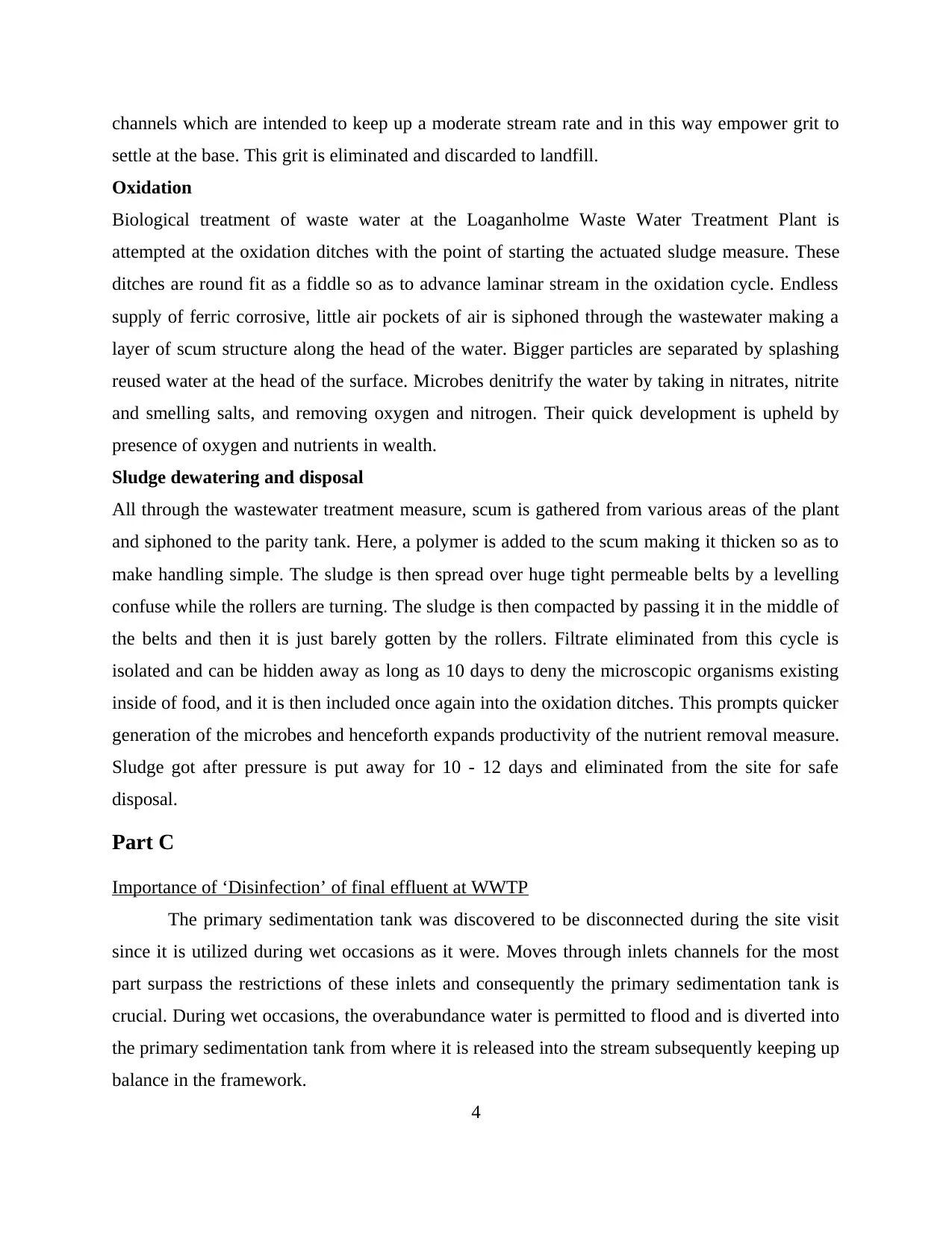
channels which are intended to keep up a moderate stream rate and in this way empower grit to
settle at the base. This grit is eliminated and discarded to landfill.
Oxidation
Biological treatment of waste water at the Loaganholme Waste Water Treatment Plant is
attempted at the oxidation ditches with the point of starting the actuated sludge measure. These
ditches are round fit as a fiddle so as to advance laminar stream in the oxidation cycle. Endless
supply of ferric corrosive, little air pockets of air is siphoned through the wastewater making a
layer of scum structure along the head of the water. Bigger particles are separated by splashing
reused water at the head of the surface. Microbes denitrify the water by taking in nitrates, nitrite
and smelling salts, and removing oxygen and nitrogen. Their quick development is upheld by
presence of oxygen and nutrients in wealth.
Sludge dewatering and disposal
All through the wastewater treatment measure, scum is gathered from various areas of the plant
and siphoned to the parity tank. Here, a polymer is added to the scum making it thicken so as to
make handling simple. The sludge is then spread over huge tight permeable belts by a levelling
confuse while the rollers are turning. The sludge is then compacted by passing it in the middle of
the belts and then it is just barely gotten by the rollers. Filtrate eliminated from this cycle is
isolated and can be hidden away as long as 10 days to deny the microscopic organisms existing
inside of food, and it is then included once again into the oxidation ditches. This prompts quicker
generation of the microbes and henceforth expands productivity of the nutrient removal measure.
Sludge got after pressure is put away for 10 - 12 days and eliminated from the site for safe
disposal.
Part C
Importance of ‘Disinfection’ of final effluent at WWTP
The primary sedimentation tank was discovered to be disconnected during the site visit
since it is utilized during wet occasions as it were. Moves through inlets channels for the most
part surpass the restrictions of these inlets and consequently the primary sedimentation tank is
crucial. During wet occasions, the overabundance water is permitted to flood and is diverted into
the primary sedimentation tank from where it is released into the stream subsequently keeping up
balance in the framework.
4
settle at the base. This grit is eliminated and discarded to landfill.
Oxidation
Biological treatment of waste water at the Loaganholme Waste Water Treatment Plant is
attempted at the oxidation ditches with the point of starting the actuated sludge measure. These
ditches are round fit as a fiddle so as to advance laminar stream in the oxidation cycle. Endless
supply of ferric corrosive, little air pockets of air is siphoned through the wastewater making a
layer of scum structure along the head of the water. Bigger particles are separated by splashing
reused water at the head of the surface. Microbes denitrify the water by taking in nitrates, nitrite
and smelling salts, and removing oxygen and nitrogen. Their quick development is upheld by
presence of oxygen and nutrients in wealth.
Sludge dewatering and disposal
All through the wastewater treatment measure, scum is gathered from various areas of the plant
and siphoned to the parity tank. Here, a polymer is added to the scum making it thicken so as to
make handling simple. The sludge is then spread over huge tight permeable belts by a levelling
confuse while the rollers are turning. The sludge is then compacted by passing it in the middle of
the belts and then it is just barely gotten by the rollers. Filtrate eliminated from this cycle is
isolated and can be hidden away as long as 10 days to deny the microscopic organisms existing
inside of food, and it is then included once again into the oxidation ditches. This prompts quicker
generation of the microbes and henceforth expands productivity of the nutrient removal measure.
Sludge got after pressure is put away for 10 - 12 days and eliminated from the site for safe
disposal.
Part C
Importance of ‘Disinfection’ of final effluent at WWTP
The primary sedimentation tank was discovered to be disconnected during the site visit
since it is utilized during wet occasions as it were. Moves through inlets channels for the most
part surpass the restrictions of these inlets and consequently the primary sedimentation tank is
crucial. During wet occasions, the overabundance water is permitted to flood and is diverted into
the primary sedimentation tank from where it is released into the stream subsequently keeping up
balance in the framework.
4
⊘ This is a preview!⊘
Do you want full access?
Subscribe today to unlock all pages.

Trusted by 1+ million students worldwide

Part D
LR and suggestions
Stable foam is generated via a process commonly referred to as activated sludge foaming.
Such kind of foam is acknowledged to be stable, extensively enriched with floating biomass
alongside covers activated sludge tank, secondary clarifier and at times also takes place within
anaerobic digester. Gas bubble, surface active compound, hydrophobic particle and so on are
required for the generation of foam. Now, certain recommendations are given beneath to deal
with the given issue:-
Ceaseless removal of foam specifically disposes of the flocs which can float.
Strategies for augmenting the foam resistance of WWTP ought to be executed on the
grounds that nutrient removal WWTP tend to suitable conditions to foam.
The potential of sludge to foam may be substantially decreased via the usage of
chemical add-ons like poly - electrolyte for improvement of sedimentation.
Decrease in retention timing for washing out the filamentous bacteria.
5
LR and suggestions
Stable foam is generated via a process commonly referred to as activated sludge foaming.
Such kind of foam is acknowledged to be stable, extensively enriched with floating biomass
alongside covers activated sludge tank, secondary clarifier and at times also takes place within
anaerobic digester. Gas bubble, surface active compound, hydrophobic particle and so on are
required for the generation of foam. Now, certain recommendations are given beneath to deal
with the given issue:-
Ceaseless removal of foam specifically disposes of the flocs which can float.
Strategies for augmenting the foam resistance of WWTP ought to be executed on the
grounds that nutrient removal WWTP tend to suitable conditions to foam.
The potential of sludge to foam may be substantially decreased via the usage of
chemical add-ons like poly - electrolyte for improvement of sedimentation.
Decrease in retention timing for washing out the filamentous bacteria.
5
Paraphrase This Document
Need a fresh take? Get an instant paraphrase of this document with our AI Paraphraser
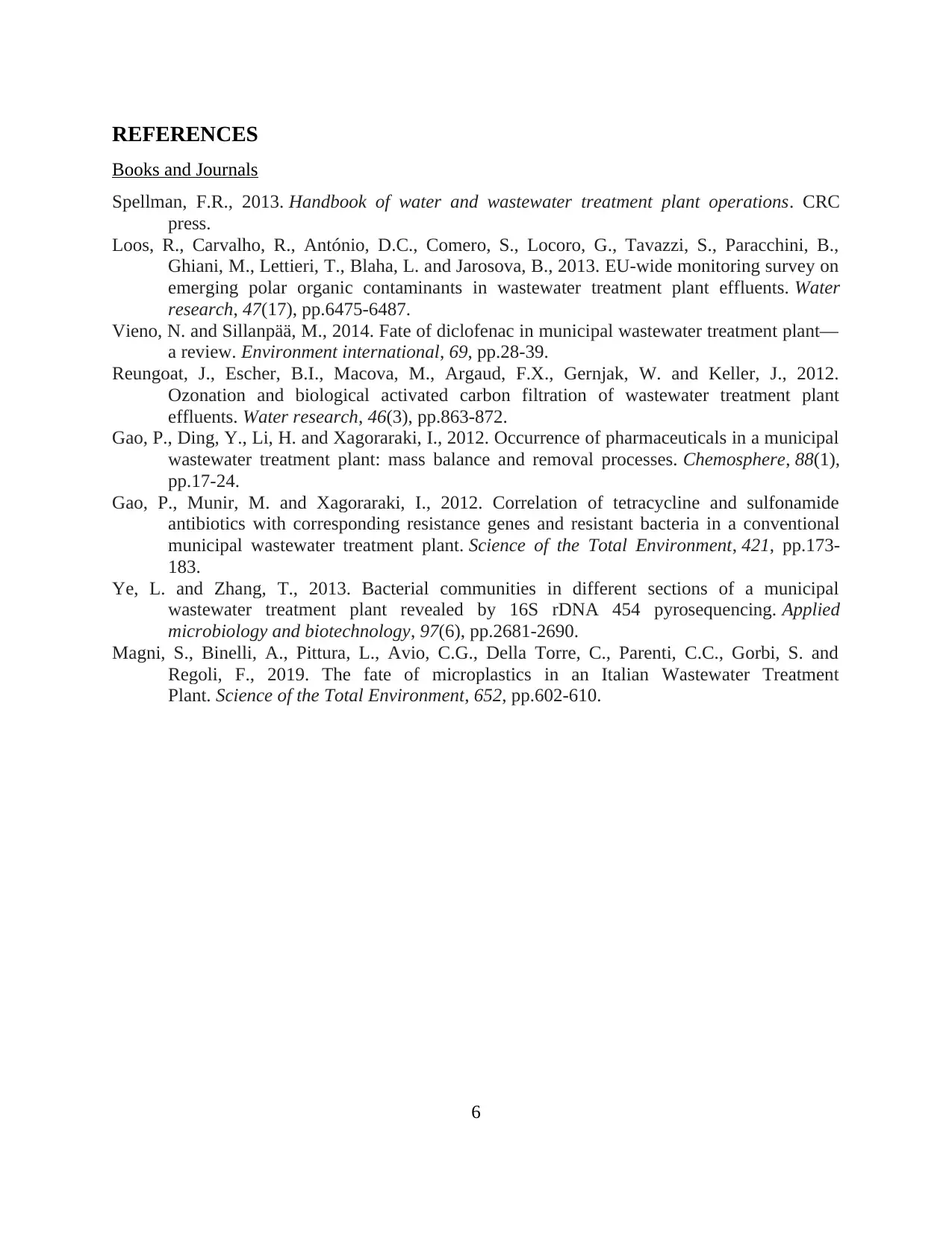
REFERENCES
Books and Journals
Spellman, F.R., 2013. Handbook of water and wastewater treatment plant operations. CRC
press.
Loos, R., Carvalho, R., António, D.C., Comero, S., Locoro, G., Tavazzi, S., Paracchini, B.,
Ghiani, M., Lettieri, T., Blaha, L. and Jarosova, B., 2013. EU-wide monitoring survey on
emerging polar organic contaminants in wastewater treatment plant effluents. Water
research, 47(17), pp.6475-6487.
Vieno, N. and Sillanpää, M., 2014. Fate of diclofenac in municipal wastewater treatment plant—
a review. Environment international, 69, pp.28-39.
Reungoat, J., Escher, B.I., Macova, M., Argaud, F.X., Gernjak, W. and Keller, J., 2012.
Ozonation and biological activated carbon filtration of wastewater treatment plant
effluents. Water research, 46(3), pp.863-872.
Gao, P., Ding, Y., Li, H. and Xagoraraki, I., 2012. Occurrence of pharmaceuticals in a municipal
wastewater treatment plant: mass balance and removal processes. Chemosphere, 88(1),
pp.17-24.
Gao, P., Munir, M. and Xagoraraki, I., 2012. Correlation of tetracycline and sulfonamide
antibiotics with corresponding resistance genes and resistant bacteria in a conventional
municipal wastewater treatment plant. Science of the Total Environment, 421, pp.173-
183.
Ye, L. and Zhang, T., 2013. Bacterial communities in different sections of a municipal
wastewater treatment plant revealed by 16S rDNA 454 pyrosequencing. Applied
microbiology and biotechnology, 97(6), pp.2681-2690.
Magni, S., Binelli, A., Pittura, L., Avio, C.G., Della Torre, C., Parenti, C.C., Gorbi, S. and
Regoli, F., 2019. The fate of microplastics in an Italian Wastewater Treatment
Plant. Science of the Total Environment, 652, pp.602-610.
6
Books and Journals
Spellman, F.R., 2013. Handbook of water and wastewater treatment plant operations. CRC
press.
Loos, R., Carvalho, R., António, D.C., Comero, S., Locoro, G., Tavazzi, S., Paracchini, B.,
Ghiani, M., Lettieri, T., Blaha, L. and Jarosova, B., 2013. EU-wide monitoring survey on
emerging polar organic contaminants in wastewater treatment plant effluents. Water
research, 47(17), pp.6475-6487.
Vieno, N. and Sillanpää, M., 2014. Fate of diclofenac in municipal wastewater treatment plant—
a review. Environment international, 69, pp.28-39.
Reungoat, J., Escher, B.I., Macova, M., Argaud, F.X., Gernjak, W. and Keller, J., 2012.
Ozonation and biological activated carbon filtration of wastewater treatment plant
effluents. Water research, 46(3), pp.863-872.
Gao, P., Ding, Y., Li, H. and Xagoraraki, I., 2012. Occurrence of pharmaceuticals in a municipal
wastewater treatment plant: mass balance and removal processes. Chemosphere, 88(1),
pp.17-24.
Gao, P., Munir, M. and Xagoraraki, I., 2012. Correlation of tetracycline and sulfonamide
antibiotics with corresponding resistance genes and resistant bacteria in a conventional
municipal wastewater treatment plant. Science of the Total Environment, 421, pp.173-
183.
Ye, L. and Zhang, T., 2013. Bacterial communities in different sections of a municipal
wastewater treatment plant revealed by 16S rDNA 454 pyrosequencing. Applied
microbiology and biotechnology, 97(6), pp.2681-2690.
Magni, S., Binelli, A., Pittura, L., Avio, C.G., Della Torre, C., Parenti, C.C., Gorbi, S. and
Regoli, F., 2019. The fate of microplastics in an Italian Wastewater Treatment
Plant. Science of the Total Environment, 652, pp.602-610.
6
1 out of 8
Related Documents
Your All-in-One AI-Powered Toolkit for Academic Success.
+13062052269
info@desklib.com
Available 24*7 on WhatsApp / Email
![[object Object]](/_next/static/media/star-bottom.7253800d.svg)
Unlock your academic potential
Copyright © 2020–2025 A2Z Services. All Rights Reserved. Developed and managed by ZUCOL.





